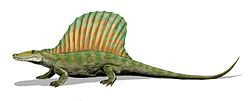| Stereophallodon Temporal range: Permian | |
|---|---|
 | |
| Restoration | |
| Scientific classification | |
| Domain: | Eukaryota |
| Kingdom: | Animalia |
| Phylum: | Chordata |
| Clade: | Synapsida |
| Family: | † Ophiacodontidae |
| Genus: | † Stereophallodon Romer, 1937 |
| Type species | |
| Stereophallodon ciscoensis Romer, 1937 | |
Stereophallodon is an extinct genus of non-mammalian synapsids. [1]





